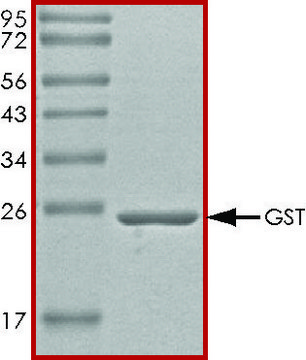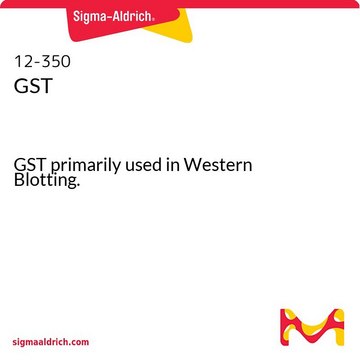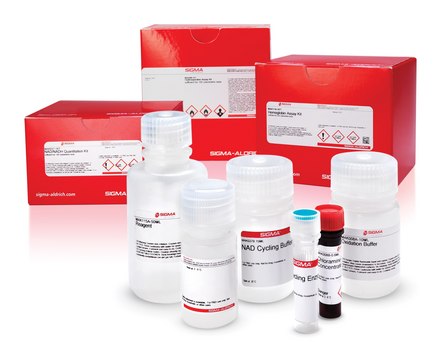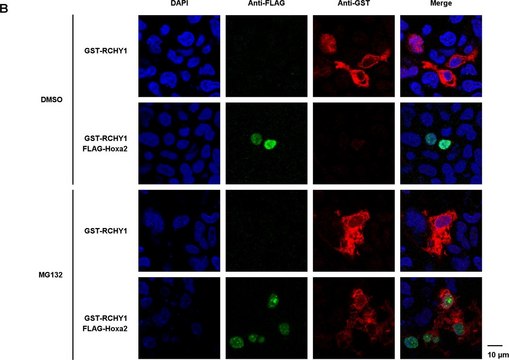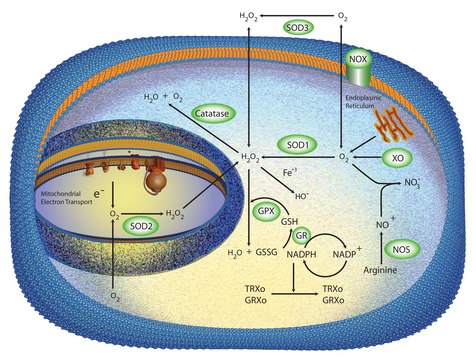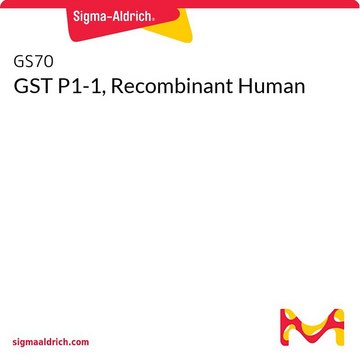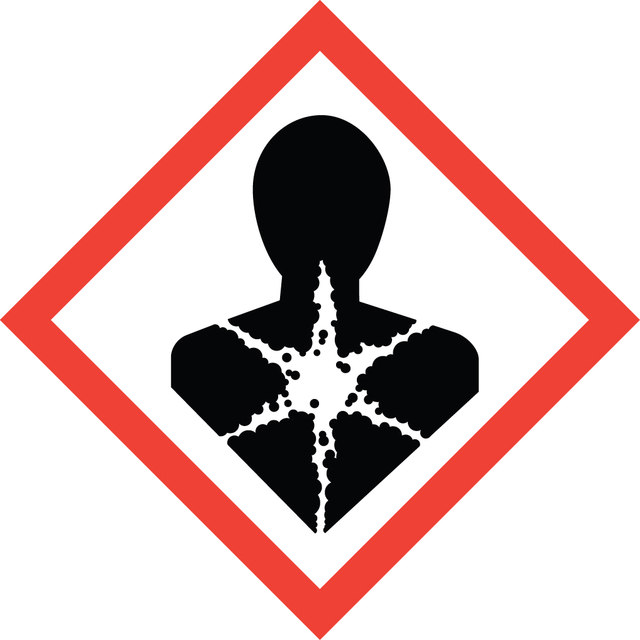G8642
Glutathione S-Transferase from human placenta
lyophilized powder, 25-125 units/mg protein
Synonym(s):
GST, Glutathione S-alkenetransferase, Glutathione S-alkyltransferase, Glutathione S-aralkyltransferase, Glutathione S-aryltransferase, Glutathione S-epoxidetransferase, RX: Glutathione R-transferase
Sign Into View Organizational & Contract Pricing
All Photos(1)
About This Item
CAS Number:
MDL number:
UNSPSC Code:
12352204
NACRES:
NA.47
Recommended Products
form
lyophilized powder
specific activity
25-125 units/mg protein
composition
Protein, ~40% biuret
storage temp.
−20°C
Gene Information
human ... GSTM1(2944) , GSTP1(2950)
General description
Glutathione S-transferase (GST) is a major detoxification enzyme, and exists as multiple cytoplasmic and membrane-bound isozymes. Cytoplasmic isoforms of GST are encoded by five genes, namely α, γ, μ, σ and π. α, μ and π are the most abundant forms in mammals. GSTπ is the isoform of this enzyme found in placenta and is composed of 209 amino acids.
Glutathione S-transferase mu 1 (GSTM1) is mapped to human chromosome 1p13.3.
Application
Glutathione S-Transferase from human placenta has been used for the immunization of rabbits for the production of specific anti-π-GST antibodies, to determine whether total anti-π-GST antibodies are more specific and reactive as compared to anti-peptide antibodies.
Glutathione S-Transferase from human placenta has been used in antigen microarray and informatics analysis.
Biochem/physiol Actions
Glutathione S-transferase (GST) catalyzes conjugation reactions during phase II metabolism. This enzyme also confers protection against catabolic products of peroxidized lipid and oxidized DNA, and ROS (reactive oxygen species) or electrophiles.
Glutathione S-transferase (GST) catalyzes the reduction of dehydroascorbic acid to ascorbic acid in the presence of glutathione. GST exhibits neuroprotective action, by eliminating oxidants (exogenous and endogenous), detoxifying therapeutic drugs and other toxins in the environment. Mutation in this gene is known to cause epilepsy. Deletion of the gene may result in cancer.
Glutathione S-transferases are a family of proteins that catalyze the conjugation of reduced glutathione with a variety of hydrophobic chemicals containing electrophilic centers.
Glutathione S-transferases are a protein family catalyzing conjugation of reduced glutathione with various hydrophobic chemicals.
Unit Definition
One unit will conjugate 1.0 μmole of 1-chloro-2,4-dinitrobenzene with reduced glutathione per min at pH 6.5 at 25°C.
Physical form
Lyophilized powder containing Tris buffer salts, reduced glutathione and EDTA.
Analysis Note
Protein determined by biuret.
Purified and assayed by a modification of the method of Simons and Vander Jagt.
Enzymatic activities are based on the conjugation of reduced glutathione with a second substrate. The individual proteins generally have activity with more than one class of substrate.
Purified and assayed by a modification of the method of Simons and Vander Jagt.
Enzymatic activities are based on the conjugation of reduced glutathione with a second substrate. The individual proteins generally have activity with more than one class of substrate.
inhibitor
related product
Product No.
Description
Pricing
Signal Word
Danger
Hazard Statements
Precautionary Statements
Hazard Classifications
Resp. Sens. 1
Storage Class Code
11 - Combustible Solids
WGK
WGK 1
Flash Point(F)
Not applicable
Flash Point(C)
Not applicable
Regulatory Information
常规特殊物品
Choose from one of the most recent versions:
Already Own This Product?
Find documentation for the products that you have recently purchased in the Document Library.
A multi-stage genome-wide association study of bladder cancer identifies multiple susceptibility loci
Rothman N, et al.
Nature Genetics, 42(11), 978-978 (2010)
Functional genetic variants of glutathione S-transferase protect against serum ascorbic acid deficiency
Cahill LE, et al.
American Journal of Clinical Nutrition, 90(5), 1411-1417 (2009)
Association of GSTT1 and GSTM1 polymorphisms in South Indian Epilepsy Patients
Prabha TS, et al.
Indian Journal of Experimental Biology, 783-787 (2016)
Glutathione S-transferase M1 and T1 null genotype frequency distribution among four tribal populations of western India
Suthar PC, et al.
Journal of genetics, 1-14 (2018)
J D Hayes et al.
Critical reviews in biochemistry and molecular biology, 30(6), 445-600 (1995-01-01)
The glutathione S-transferases (GST) represent a major group of detoxification enzymes. All eukaryotic species possess multiple cytosolic and membrane-bound GST isoenzymes, each of which displays distinct catalytic as well as noncatalytic binding properties: the cytosolic enzymes are encoded by at
Our team of scientists has experience in all areas of research including Life Science, Material Science, Chemical Synthesis, Chromatography, Analytical and many others.
Contact Technical Service
